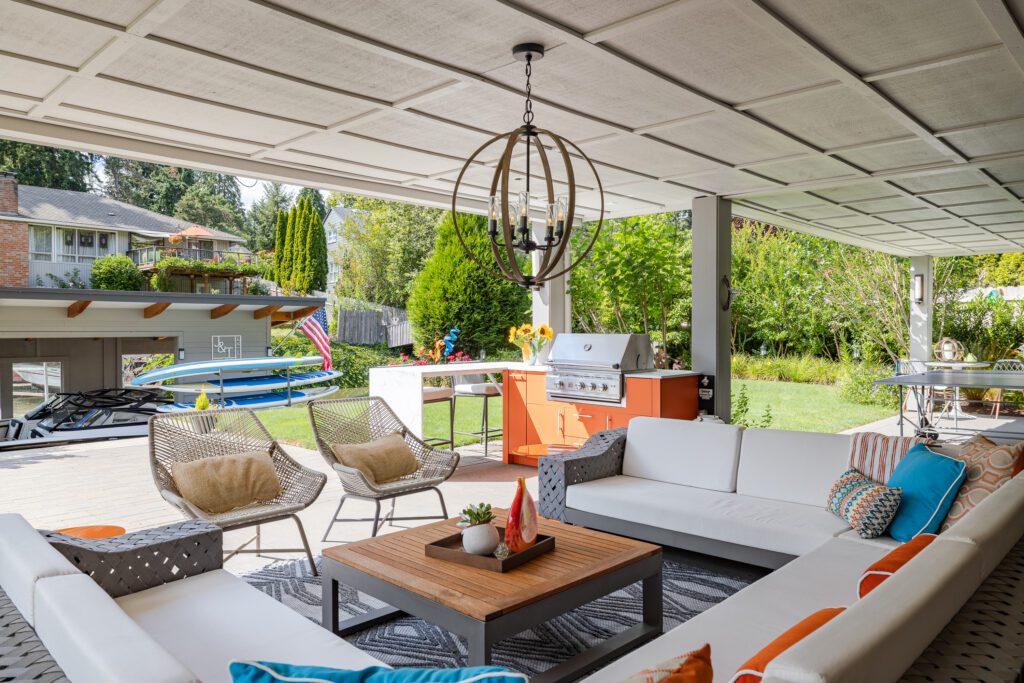Designing Functional, Cozy, and Inviting Extensions of Your Living Area
In recent years, the concept of home has evolved from a mere shelter to a sanctuary—a place where we not only live but also work, play, and find solace. As part of this transformation, outdoor spaces have gained significant attention, becoming integral extensions of our living areas. Today we will explore how to maximize outdoor spaces, transforming them into functional, cozy, and inviting environments. We will discover design strategies, the importance of biophilia, and the mental wellness benefits of well-designed outdoor spaces.
The Significance of Outdoor Living Spaces
Outdoor spaces offer a unique opportunity to expand the usable area of your home, providing a seamless transition between the indoors and outdoors. These areas can serve multiple functions: from relaxing retreats to entertaining zones, dining areas, and even workspaces. The key to maximizing these spaces lies in thoughtful design and a focus on comfort, functionality, and aesthetics.

Designing Functional Outdoor Spaces
When it comes to designing a functional outdoor space, it’s essential to consider the specific activities you plan to enjoy there. Here are some tips to help you create a space that meets your needs:
- Define the Purpose: Start by identifying the primary functions of your outdoor area. Will it be used for dining, lounging, gardening, or entertaining? Clearly defining the purpose will guide your design decisions.
- Zoning: Create distinct zones for different activities. For example, designate one area for dining with a table and chairs, another for lounging with comfortable seating, and a separate space for a garden or play area. Use rugs, planters, or furniture arrangements to delineate these zones.
- Furniture Selection: Choose furniture that is both stylish and functional. Opt for weather-resistant materials like teak, aluminum, or synthetic wicker that can withstand the elements. Multi-functional furniture, such as benches with storage or extendable tables, can maximize utility in smaller spaces.
- Lighting: Adequate lighting is crucial for extending the usability of your outdoor space into the evening. Incorporate a mix of ambient, task, and accent lighting to create a warm and inviting atmosphere. Solar-powered lights, string lights, and lanterns are great options.
- Shelter and Shade: To make your outdoor space comfortable year-round, consider adding elements that provide shelter and shade. Pergolas, awnings, and umbrellas can protect against harsh sunlight and rain, while also adding architectural interest.
- Outdoor Kitchens and Bars: For those who love to entertain, an outdoor kitchen or bar can be a fantastic addition. Equip it with essentials like a grill, sink, refrigerator, and counter space to make outdoor cooking and dining a breeze.

Creating Cozy and Inviting Spaces
A cozy outdoor space invites you to unwind and spend time outside. Here are some tips to make your outdoor area feel warm and welcoming:
- Comfortable Seating: Invest in plush seating options like cushioned sofas, lounge chairs, and hammocks. Add outdoor throw pillows and blankets to enhance comfort and coziness.
- Textures and Layers: Incorporate a variety of textures and layers to create visual interest and warmth. Use outdoor rugs, textiles, and decorative pillows to add softness and depth to your space.
- Greenery and Plants: Plants play a significant role in making outdoor spaces feel alive and inviting. Use a mix of potted plants, hanging baskets, and garden beds to bring in natural beauty and color. Choose plants that thrive in your climate and require minimal maintenance.
- Fire Features: A fire pit or outdoor fireplace can become the focal point of your outdoor space, providing warmth and a cozy ambiance. It’s perfect for gathering around with family and friends on cool evenings.
- Personal Touches: Decorate your outdoor space with personal touches that reflect your style and personality. Hang artwork, display sculptures, or add water features to create a space that feels uniquely yours.

Extending the Living Space
To truly maximize your outdoor space, it’s important to create a seamless flow between indoor and outdoor areas. Here are some strategies to achieve this:
- Harmonious Design: Ensure that the design elements of your outdoor space complement your indoor decor. Use a similar color palette, materials, and style to create a cohesive look that blurs the boundaries between inside and out.
- Large Windows and Doors: Install large windows or sliding glass doors that open up to your outdoor space. This not only enhances the visual connection but also allows natural light to flood your interior, making both spaces feel larger and more open.
- Outdoor Living Rooms: Treat your outdoor area as an extension of your living room. Arrange furniture in a way that promotes conversation and relaxation. Add outdoor rugs, coffee tables, and lighting to create a comfortable and functional outdoor living room.
- All-Weather Solutions: To make your outdoor space usable throughout the year, incorporate all-weather solutions like outdoor heaters, fans, and retractable screens. These additions can help you stay comfortable regardless of the weather.

Biophilia and Mental Wellness
Biophilia, the innate human connection to nature, plays a crucial role in designing outdoor spaces that promote mental wellness. Here’s how integrating biophilic design principles can enhance your outdoor living experience:
- Natural Elements: Incorporate natural elements like wood, stone, and water into your outdoor space. These materials not only look beautiful but also have a calming effect on the mind.
- Greenery: Surround yourself with plants and greenery. Studies have shown that exposure to nature can reduce stress, improve mood, and enhance cognitive function. Create a lush garden, plant vertical walls, or simply add potted plants to your outdoor area.
- Natural Light: Maximize natural light in your outdoor space. Sunlight is a natural mood booster and can help regulate sleep patterns. Arrange seating areas to take advantage of the sun’s path and provide shade options for comfort.
- Water Features: The sound of flowing water is soothing and can create a sense of tranquility. Consider adding a fountain, pond, or waterfall to your outdoor space to enhance the biophilic experience.
- Wildlife-Friendly Design: Create a habitat that attracts birds, butterflies, and other wildlife. Install bird feeders, plant native flowers, and provide water sources to invite nature into your outdoor space.
Case Study: Transforming a Small Urban Balcony
Let’s explore a real-life example of maximizing a small urban balcony to illustrate these principles in action.
The Challenge:
A small balcony in an urban apartment with limited space for seating and plants.
The Solution:
- Purpose: The primary goal was to create a relaxing retreat for reading and enjoying morning coffee.
- Zoning: The balcony was divided into two zones: a seating area with a small bistro table and chairs, and a green area with potted plants and vertical planters.
- Furniture Selection: Compact, foldable furniture was chosen to save space. The chairs were cushioned for comfort, and the table had an adjustable height.
- Lighting: String lights were hung around the balcony railing to provide ambient lighting. Solar-powered lanterns added a warm glow in the evenings.
- Shelter and Shade: A retractable awning provided shade during hot summer days and shelter from light rain.
- Greenery: A mix of low-maintenance plants, such as succulents and herbs, were placed in pots and vertical planters to add greenery without taking up floor space.
- Textures and Layers: An outdoor rug and a few throw pillows added texture and comfort to the seating area.
- Personal Touches: A small water feature, wind chimes, and decorative lanterns added personality and charm to the balcony.
- Seamless Flow: The balcony door was kept open during pleasant weather, allowing the living room and balcony to feel like one continuous space.
The Result:
The transformed balcony became a cozy and inviting retreat, perfect for relaxation and unwinding. The addition of greenery and natural elements created a calming environment, enhancing the overall living experience.

Conclusion
Maximizing outdoor spaces involves thoughtful planning and design to create functional, cozy, and inviting areas that extend your living space. By incorporating elements of biophilic design and focusing on the purpose of the space and mental wellness, you can transform your outdoor area into a sanctuary that enhances your overall quality of life. Whether you have a spacious backyard or a small urban balcony, these principles can help you make the most of your outdoor space, creating a harmonious blend of comfort, functionality, and natural beauty.
Remember, the key to a successful outdoor space is to tailor it to your needs and preferences. With a little creativity and attention to detail, you can create an outdoor oasis that you’ll love spending time in, all year round.

